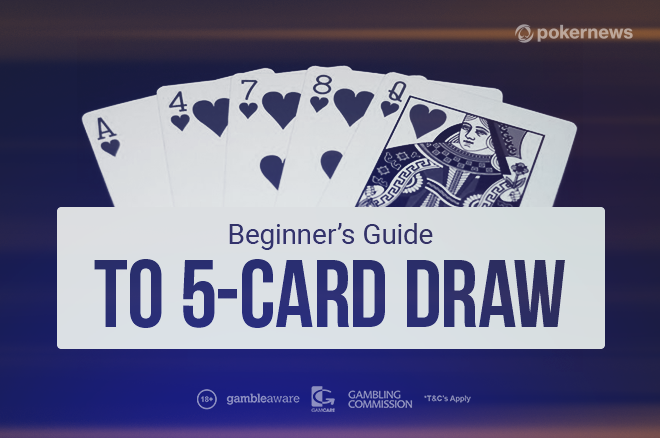How To Play Five Card Draw Poker For Beginners
Like in many other variations of poker, in Draw Poker there is a dealer, who is usually one of the players. There is also a forced bet, which forms the original pot. After the ante, all the players at the table are dealt 5 hole cards. The first to act is the player to the left of the dealer. 5 Card draw is one of the most popular poker games both on and offline, mainly because it is simple and easy for beginners to learn and play.If you are new to online poker then 5 card draw is one of the best ways to get involved and start to learn before jumping into more complicated games.
Deal, Ante & Blinds. In five-card draw poker, one of the players will be given the responsibility of.
If you want to learn how to play the simplest form of poker, Five Card Draw is the right choice. Most new poker players resort to this version before they go on to playing other varieties of the game. You may not find it often at casinos, but it has been around for long definitely a useful poker game to learn.
Here is our beginner guide to Five Card Draw poker.
Make sure that you do some reading before you join the poker table. Get to know the essentials of the game to get a general idea how to approach play. Go over the rules and try to remember the highlights and main points.
As the name suggests, this is a variant of stud poker. 7-card stud is also the 'S' game in the H.O.R.S.E. Poker — but if you are still learning how to play poker, it's probably too early for you. Here are some excellent tips to help beginners play a winning game of Five Card Stud Poker: Play only the best starting hands. It is better to fold weak hands instead of losing money on them in the long run. Players must observe their opponents carefully as it will help them plan their own moves better.
Draw poker is typically played with 6 players at a table, and it can be a limit, pot limit or a no-limit game. It uses a standard 52-card deck, shuffled before every hand.
Standard hand rankings still stand; make sure to review them before playing. The highest rank is the Royal Flush (10, J, Q, K and Ace of the same suit), while the lowest is the High Card (no combination formed, the highest card determines the hand value).
The objective is to complete the best 5-card poker hand (being a draw game, initially dealt cards can be discarded and replaced with new ones).
The session begins with the Big Blind and the Small Blind. This helps stimulate the action. The bets are assigned to the players to the left of the dealer. Once both Blinds are placed, the dealer can begin to distribute cardsstarting with the player to the left.
The hands are underway and each player receives 5 cards facing down. When the circle around the table is complete and every player has a hand to play, the first round of betting ensues.
The player to the left of the Big Blind gets to take action first. Available options include folding their hand, calling the current bet or raising it up.
If nobody raises, the player who placed the Big Blind receives the opportunity to check (make no bet, but still retain their hand and not fold).
After the first round of betting is complete, the players enter a stage where they have the option to discard any or all of their cards. Should they opt to do so, they can draw new ones.
Those who prefer not to discard anything, they should go for the option “Stand Pat” when it’s their turn to act.
Once the draw is concluded, another round of betting takes place. It is the final round of betting, during which players have the option to bet and take actions as before.
If there are at least two players left in the game after this, the remaining hands go into the showdown. If everyone has folded and one player remains, he or she wins the pot.
The showdown is the final stage of the game during which hands are compared. The player with the best 5-card poker hand wins the pot.
Should there be a tie between two final players, they will split the pot in two equal halves.
Raise First In

Our Objective
Our primary focus when playing 5-card draw should be attempting to make three-of-a-kind. We look for decent pairs and then draw 3 cards hoping to make trips. Drawing three gives us statistically the highest chance to make trips. You will often see players at your limit holding on to one of their kickers and drawing only two cards, but in most cases this is incorrect.

The exception is that there are already 2 limpers in the pot, in which case it's fine to limp behind some straight-draws and flush-draws, but gut-shots should typically be folded. We don't want to make hard and fast rules here but there are some exceptions vs passive opponents where we can get away with cold-calling these hands for one of the two following reasons in a no-limit-game
- Our opponent just can't fold at showdown and hence we have great implied odds. (Note that this applies purely to no-limit 5-card draw games and it's nearly always going to be a mistake to call a raise preflop with a straight-draw or flush-draw in a limit game)
- Our opponent plays extremely face up on the final street and we can pick up pots as a bluff. (Note that again this applies more frequently to no-limit games as our opponent is less likely to fold anything to a min-bet in a limit game)
RFI Ranges
- UTG KKxxx+
- MP QQxxx+
- CO JJxxx+
- BTN 99xxx+
- SB TTxxx+ (however it's OK to complete some weaker hands with reasonable potential)
Isolating
Pairs lower than JJxxx are referred to as “shorts” and are generally considered trouble hands in 5-card draw, so play with caution. These should often be folded preflop, but again it is somewhat villain dependent. We might be able to play some smaller pairs as limp-behinds and take the opportunity to turn them into a bluff on the river vs face up opponents.
The Draw
- If we have a pair we draw 3 and try and make trips.
- If we have trips, we draw two and try to make Quads or a boat.
- If we have a flush-draw or straight-draw we draw one and try to hit.
- If we have total garbage (usually in a free play situation) we can hold on to cards above a Queen or Jack and replace the others.
Hand Reading
3 cards – In most cases this will indicate that the player has a pair and is trying to pick up three-of-a-kind. A very bad player might be drawing to a flush or straight with only 2 cards. It's always worth taking a note of this kind of thing if you discover at showdown that the player drew 3 cards and does not even have a pair when he shows down.
How To Play Five Card Draw Poker For Beginners To Play
Showdown
5 Card Draw Poker Aol

Advanced Tactics
Our opponent will often call with 2-pair in this situation hoping to either beat our 2-pair or bluff-catch against our busted draws. In other words, drawing 1 allows us to represent a weaker range with a strong hand. Note that this only makes sense against semi-decent opponents. The average fish may not even care how many cards we draw, in which case we should always draw 2 with trips and give ourselves the maximum chance of improving.
Our opponent will usually fold unless he improve to trips or better. And even if he has trips it won't theoretically be a correct call unless he expects us to be bluffing like this since we are representing a 5-card hand which beats his trips. Obviously we have to be careful not to over-use this line. If we stand-pat every hand it's going to become obvious pretty quickly that we don't have anything.

Using Position to Bluff
- They would lead for value if they hit a strong draw
- They would lead for value a decent amount if they had 2 pair
- It's overall pretty unlikely that they'll spike their draw
So if our opponent has a tendency to go for hugely unlikely draws then we can defend much wider in position even with some weak hands ourselves. We might not get the pot-odds to defend the hand, but if our opponent simply check folds final-street every time he misses, our preflop odds don't matter.